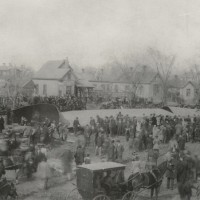Molly Crusen Bishop: The West Bluff Water Tower Disaster
- Details
- Published on Tuesday, 18 July 2017 15:59
- Written by Molly Crusen Bishop
The West Bluff Water Tower Disaster
By Charles Needham and Molly Crusen Bishop
Editor’s note: This is the first in a series of stories from Molly Crusen Bishop that will be based on the essays about the West Bluff by her grandfather, Charles Needham.
Charles Needham was born to Patrick and Ellen Needham in Peoria in the 1880s. Patrick worked for the Rock Island Railroad line and later at the Glucose Factory, which was a part of the distilleries. He was a night watchman and later a Teamster, driving the horse and carts loaded with barrels, once they were done with that process in the distillery.
They lived on Barker Avenue, on Peoria’s West Bluff, building the house in which three generations of Needhams, and ultimately Crusens, were raised. Charlie attended Bradley Polytechnic Institute. He had a nice job as a traffic manager at Larkins and was also a paid political speech writer in Peoria in the 1930-1950s, until he passed in 1957. He wrote several essays with first-hand descriptions of what life was like on the West Bluff. My grandfather was also a staunch Roosevelt Democrat, incidentally.
I have read through his essays, and have done extensive research of my own as well, and feel comfortable retelling his stories with my own information and words, relaying the commonality I share as a writer with my grandfather; not only his story-keeper, but a storyteller as well.
The West Bluff of Peoria was filled with prairies and cornfields on the west side of the west side, shall we say. The Uplands were cow pastures and crops, so the area between what is now University Street and Farmington Road, was sparsely settled in the 1880s. There was a boardwalk that ran along Russell Street. Bradley Park was just a large stretch of woods and the territory later known as Summit Boulevard was a dump for scrap.
Charlie remembered a house called Harper House, on Main Street, which the neighbors referred to as an “Old ladies home.” There were random homes scattered about and young boys like Charlie could find baseball diamonds and football fields everywhere. Bradley Avenue was formerly called Hansel Street and University Street was formerly called Bradley. Charlie recounts he could stand near St. Mark Church and see all the way to the back of West Peoria, near Swords hill, as a young boy.
“Here begins the saga I have entitled, The West Bluff Water Tower Disaster,” states my grandfather in the essay under his byline, Charles Stuart Parnell Needham.
Charlie was a young boy of nine on what was a sunny spring day on Peoria’s West Bluff, on March 30, 1894. Charlie and many other children were enjoying a school spring vacation day, playing near Main Street and the Bourland area.
St. Mark’s old rickety wooden rectory house was located near 401 and 403 Bourland Avenue. Father O’Reilly was the pastorate and Archbishop Gerald Bergen lived on College Street near where this tale takes place.
On this glorious spring day in 1894, Charlie and the other children roamed near where there was a large water tower, near then 404 S. Bourland. There were scattered houses near there and Underhill, but many open lots as well.
This water tower, or what was known as the West Bluff Standpipe, was made of steel and wood and had been built to give more water pressure to the surging population on the west bluff.
Children were running and playing, powerful businessmen in suits with long coats and beautiful hats were walking to and from their businesses, and ladies, with their long dresses and fancy hats, commanded their children this way or that, leaving the local corner market. Charlie refers to the top of Main Street as the top of the hill.
The water tower was about 30 feet in diameter and approximately 130 feet high. Leaks were springing up on the massive tower and strong and busy men climbed up on 30-50 feet ladders, hammering, caulking, and plugging up the leaks as best as they could. There was major pressure from the millions of gallons of water inside the tower and as the men were pounding, a disaster was about to take place.
Charlie and about nine other boys aged 9-15 were playing in the street just beneath the tower and watched the men work. Trolley cars and horses and buggies could be heard and seen, and smelled. Main Street was just a block or so away.
The strain on the riveted steel in the legs beneath the tower, on the lower portion of the tower, caused the steel and wood beams to break with a thunderous explosion, causing the water tower to burst into a tsunami in an eastward direction.
The wood splintered instantly into hundreds of pieces and the steel broke apart into jagged spikes and sheets. The wood, the steel, the water came down upon the boys with great force of doom. Charlie’s friend Frank Hogan, an altar boy at St. Mark, was caught in the chest by a sheet of steel and was sliced into two pieces instantly. Charlie’s other friend, Frank Caldwell, who lived across the street from Frank Hogan, was crushed by a large piece of wood that hit him like a battering ram. Frank Caldwell languished and suffered for two days before dying from his injuries.
The other boys were badly injured, and they were all half-drowned.
“I heard the splintering and boom and saw the water approaching us rapidly. I was carried out of the way of a large piece of jagged steel in one second when the force of the water grabbed hold of me and swept me away. The water carried me over a block down on Bourland, and near Windom Street, and then the water recessed back down the street toward the Main Street Hill,” Charlie Needham wrote.
The wave of water moved him towards College and Main, where he was able to see above the water enough to see the streetcar trolley wire pole. He grabbed the top of the pole to stop himself from being carried along with the wave any further. Some men standing in knee-deep water managed to get hold of him and pulled him out of the wave. His clothes were ruined and he was half-drowned, but there was not a scratch on his body.
The water stopped just at the edge of the alley near St. Mark’s rectory, according to Father O’Reilly’s housekeeper Miss Ellen Head. She saw the force of water coming and believed it was going to sweep the rickety old rectory away with it. She saw the water stop at the alley’s edge and head toward Main Street Hill.
There was another two-story house to the south of the tower. A mother left her sleeping baby on the second floor prior to the explosion to go next door to borrow a much-needed missing ingredient for her day’s baking. That’s when the water tower exploded and a large sheet of steel hit her house crashing into the second story where her baby was sleeping. The baby was safe, but the damage incurred made it impossible to retrieve the baby from inside the house. A ladder had to be put up to a window to get her baby to safety.
Charlie was an altar boy for Father O’Reilly at St. Mark’s early little wooden church, with Frank Hogan and Frank Caldwell. They served at weddings together and he stated that there weren’t many weddings in the little church in the early days. The boys would rotate serving at masses and baptisms and Vespers and Benedictions. I am very saddened the two Franks lost their lives so young. I am very blessed Charlie had a guardian angel of some sort and thankful to be here today, being a story keeper and a storyteller because he survived the West Bluff Water Tower Disaster over 123 years ago and held a small piece of Peoria’s West Bluff history in his memory and in his written word.
Study the beautifully haunting photo that shows the aftermath of this tragic experience my grandfather endured. I am especially thankful to Christopher Farris and to the Peoria Public Library Local Historical Collection, with their Grassel Collection. This photograph is titled the West Bluff Standpipe.
This is the first in a series based upon my grandpa’s essays from the 1880s and 1890s about the West Bluff and thorough and extensive research of my own over the past four years.



















































